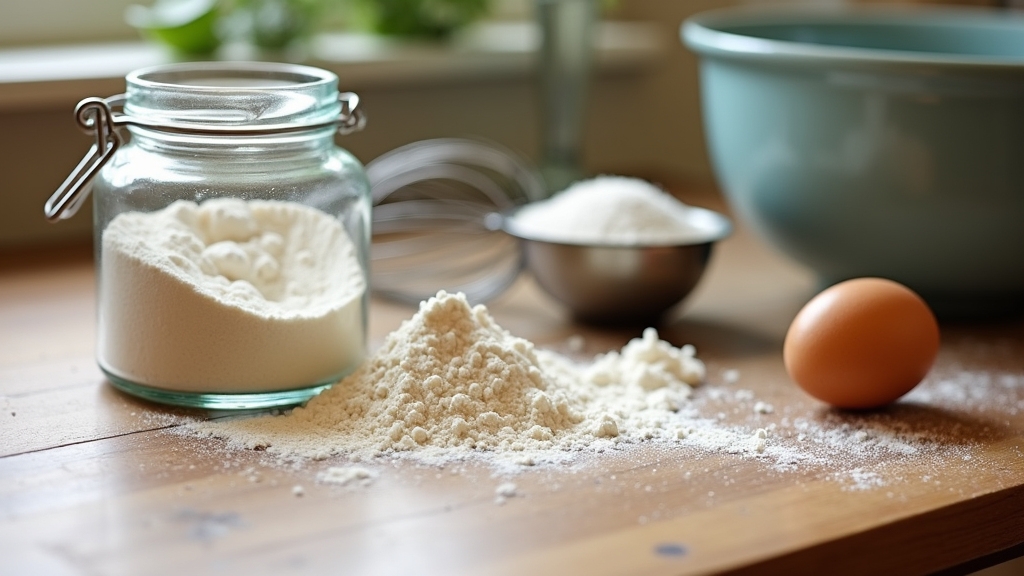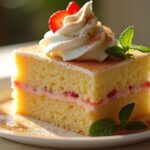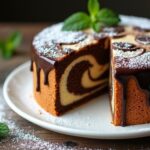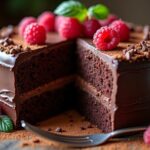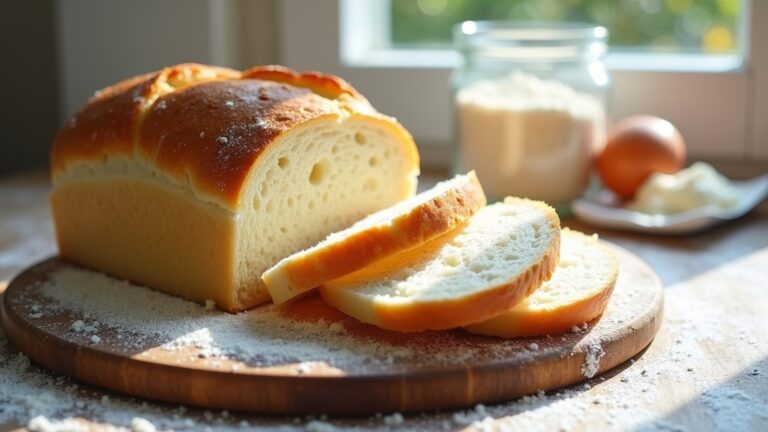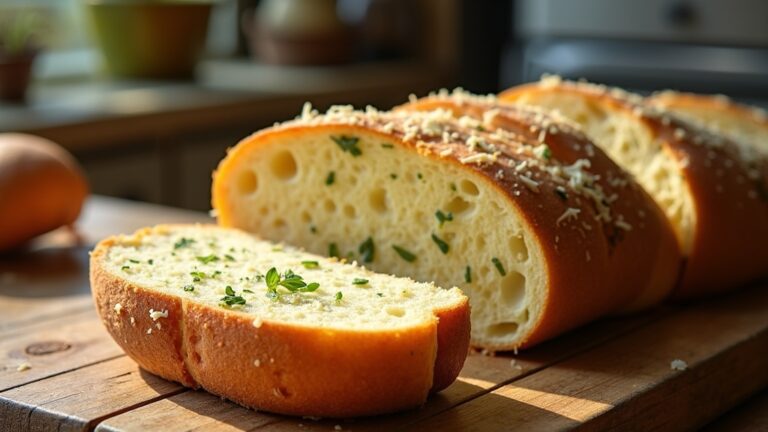Cake Flour Recipe
To make your own cake flour at home, I use a simple combination of all-purpose flour and cornstarch. Just take one cup of all-purpose flour, remove two tablespoons, and replace them with two tablespoons of cornstarch. Sift the mixture together to aerate it, which helps create a lighter texture in your cakes. This easy method guarantees fluffy results that’ll impress anyone! If you want to learn more about baking techniques and tips, keep going!
Contents
History
When I think about cake flour, I can’t help but appreciate its rich history, which dates back centuries to the heart of European baking traditions. Originating from finely milled soft wheat, cake flour became a staple in the kitchens of skilled bakers who understood the importance of texture. The baking science behind it reveals that the lower protein content allows for a tender crumb, perfect for delicate cakes. As trends evolved, so did this ingredient, adapting to the demands for lighter, fluffier desserts. Today, we continue to innovate with cake flour, exploring its potential in gluten-free options and alternative grains. It’s fascinating to witness how this humble flour has shaped our baking landscape, inviting creativity and experimentation in every mix.
Recipe
Cake flour is a finely milled flour that is perfect for creating light and fluffy cakes. Its lower protein content compared to all-purpose flour means that it produces less gluten, resulting in a tender crumb that is ideal for cakes, cupcakes, and some pastries. Making your own cake flour at home is simple and requires only two ingredients. This homemade version can be a great alternative when you don’t have cake flour on hand, guaranteeing that your baked goods turn out perfectly every time.
Cake flour’s lower protein content creates tender, fluffy cakes, making it easy to make your own at home with just two ingredients.
To make cake flour, you’ll need all-purpose flour and cornstarch. The cornstarch helps to inhibit gluten formation, allowing your cakes to rise beautifully and maintain a soft texture. This recipe is particularly useful for beginners who are keen to bake with the right ingredients but may not want to invest in multiple types of flour. With just a few easy steps, you can prepare cake flour that can be used in any recipe calling for this critical ingredient.
Ingredients:
- 1 cup all-purpose flour
- 2 tablespoons cornstarch
Instructions:
In a mixing bowl, measure out 1 cup of all-purpose flour and remove 2 tablespoons from it. Replace the removed flour with 2 tablespoons of cornstarch, then sift the mixture together at least twice. This guarantees that the cornstarch is evenly distributed throughout the flour, creating a light and airy cake flour blend. Your homemade cake flour is now ready to be used in your favorite cake recipes.
Extra Tips:
When measuring flour, it’s important to spoon it into your measuring cup and level it off with a knife instead of scooping directly from the bag, as this can lead to packing and result in too much flour. Additionally, if you need a larger quantity of cake flour, simply scale up the recipe while maintaining the same ratio of all-purpose flour to cornstarch. Store any leftover cake flour in an airtight container in a cool, dry place for future baking endeavors.
Cooking Steps
Now that we have our cake flour recipe in hand, it’s time to get into the cooking steps that will set us up for success. I’ll guide you through measuring the flour accurately, sifting it with cornstarch, and combining all the ingredients thoroughly. By the end of this process, you’ll be ready to create a light and fluffy cake that’s sure to impress!
Step 1. Measure Flour Accurately
Accurate measurement of flour is essential for achieving the perfect cake texture. To guarantee your cake flour is spot-on, I recommend using precise measuring techniques. First, scoop the flour gently with a spoon into your measuring cup, avoiding any compacting. Then, level it off with a straight edge; this prevents excess flour from sneaking in. If you’re looking for ultimate accuracy, consider weight conversion. One cup of cake flour typically weighs around 120 grams. Using a kitchen scale not only enhances consistency but also elevates your baking game. Remember, every gram counts when crafting that delicate crumb. By mastering these methods, you’re one step closer to creating that dreamy cake you’ve always envisioned!
Step 2. Sift With Cornstarch Blend
To achieve a light and airy texture in your cakes, I always recommend sifting the flour with a cornstarch blend. This sifting technique not only aerates the mixture but also evenly distributes the cornstarch, which softens the protein content of the flour. The cornstarch benefits are significant; it creates that delicate crumb that makes your cake melt in your mouth.
When I sift, I use a fine-mesh sieve to guarantee that no clumps remain, which could weigh down your batter. I mix one part cornstarch with every two parts of all-purpose flour for the perfect blend. This simple step elevates your baking, making your cakes lighter, fluffier, and just downright irresistible. Trust me, your taste buds will thank you!
Step 3. Combine Ingredients Thoroughly
After you’ve sifted the flour with cornstarch, it’s time to combine your ingredients thoroughly to make certain a smooth and cohesive batter. I usually begin by measuring my ingredient ratios precisely—this guarantees a balanced mix that enhances the cake’s texture. Using a stand mixer or a whisk, I employ various mixing techniques to blend everything seamlessly. Start on low speed to avoid flour clouds, then gradually increase to medium. This approach helps incorporate air, giving the cake a lightness that’s simply irresistible. Don’t rush; take your time to scrape down the sides of the bowl, ensuring no lumps remain. The goal is a silky batter that promises a delightful cake, making your baking experience both innovative and rewarding.
Step 4. Add Baking Powder Carefully
While mixing your batter, it’s vital to add baking powder carefully to guarantee an even rise. I’ve learned that the right ingredient ratios make all the difference in achieving that light, fluffy texture we all crave. I like to sift the baking powder with the flour first; this helps distribute it evenly throughout the mixture. When I measure, I always use a level spoon—too much can lead to a bitter taste, while too little may leave your cake dense. These baking tips are essential for innovation in baking, allowing you to experiment with flavors without compromising texture. So, take your time, sprinkle it in, and watch your cake transform into a masterpiece!
Step 5. Preheat the Oven
Before diving into mixing your ingredients, preheating the oven is an important step that sets the stage for baking success. I always set my oven to the ideal temperature, usually around 350°F (175°C), which is perfect for cakes. This initial warmth guarantees even baking and helps create that perfect rise. While the oven heats, I prepare my cake flour and other ingredients, maximizing efficiency. Understanding oven temperature is vital in mastering baking techniques—too hot or too cold can lead to disastrous results. Once the oven beeps, signaling it’s ready, I feel a surge of anticipation, knowing I’m one step closer to creating a delightful cake. Trust me, taking this moment to preheat is well worth it!
Nutritional Guide
Understanding the nutritional profile of cake flour can elevate your baking experience, especially if you’re mindful of dietary needs. While cake flour provides a lighter texture, it’s essential to evaluate its nutritional benefits and potential ingredient alternatives.
Here’s a quick comparison:
| Nutrient | Cake Flour (1 cup) | Whole Wheat Flour (1 cup) |
|---|---|---|
| Calories | 100 | 120 |
| Protein | 10g | 14g |
| Fiber | 1g | 6g |
Final Thoughts
As I wrap up our exploration of cake flour, I can’t help but emphasize its unique role in creating light and fluffy baked goods. Understanding how to utilize cake flour can elevate your baking game, especially for delicate cake types like chiffon or angel food. Mastering this ingredient paves the way to innovative baking techniques that can transform your creations.
Embrace cake flour for light, airy creations, and elevate your baking skills to new heights.
- Cake flour’s lower protein content guarantees tenderness.
- Sifting cake flour enhances its lightness and aeration.
- Adjusting ratios can personalize cake textures.
- Experimenting with different cake types reveals new flavors.
Frequently Asked Questions
Can I Substitute All-Purpose Flour for Cake Flour?
Absolutely, I often substitute all-purpose flour for cake flour. While the texture might differ slightly, I love the versatility it offers. It’s a great way to achieve delightful baking results without needing special ingredients!
How Do I Store Homemade Cake Flour?
I store my homemade cake flour in an airtight container to guarantee proper storage. Keeping it in a cool, dark place extends its shelf life, allowing me to enjoy baking without worrying about freshness.
What Is the Difference Between Cake Flour and Pastry Flour?
When I compare cake flour and pastry flour, I notice cake flour’s benefits for tender cakes and pastries, while pastry flour’s uses shine in flaky pie crusts. Each flour brings unique qualities to my baking adventures.
Is Cake Flour Gluten-Free?
Is cake flour gluten-free? Unfortunately, it isn’t. But I love using gluten-free alternatives like almond flour for a light, airy baking texture. Experimenting with these options can lead to delicious, innovative results in your baking!
Can I Use Cake Flour for Bread Recipes?
I’ve tried using cake flour for bread, and while it’s not typical, it can create a delightfully tender bread texture. Just adjust your expectations for baking results; it might surprise you with its unique charm!
Conclusion
To sum up, making your own cake flour is easier than you might think, and it truly elevates your baking game. You may worry that it’s not worth the effort, but trust me—once you taste the difference in texture and flavor, you’ll never look back. The lightness of your cakes will have everyone asking for your secret. So, roll up your sleeves, and let’s create something delicious together—your perfect cake awaits!
